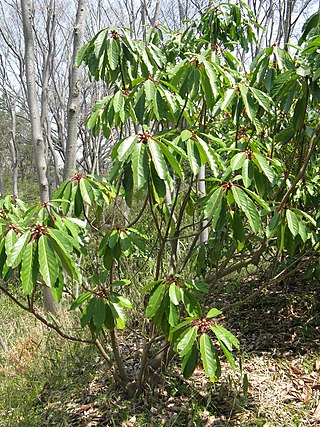
Daphniphyllum is the sole genus in the flowering plant family Daphniphyllaceae and was described as a genus in 1826. The genus includes evergreen shrubs and trees mainly native to east and southeast Asia, but also found in the Indian Subcontinent and New Guinea.

Arachniodes is a fern genus in the family Dryopteridaceae, subfamily Dryopteridoideae, in the Pteridophyte Phylogeny Group classification of 2016. A number of species in this genus are known as "holly ferns".
Koyamacalia was a genus of East Asian plants in the groundsel tribe Senecioneae within the daisy family Asteraceae. It is a synonym of the accepted genus Parasenecio.

Daphniphyllum macropodum is a shrub or small tree found in China, Japan and Korea. Like all species in the genus Daphniphyllum, D. macropodum is dioecious, that is male and female flowers are borne on different plants. The timber is used in China in construction and furniture making. It is grown as an ornamental plant, chiefly for its foliage.

Gampi or Ganpi are a group of Japanese shrubs, members of the genus Wikstroemia, some of which have been used for making paper since the 8th century. It is used to make the high quality washi paper, as are kōzo and mitsumata trees.

Carex morrowii, the kan suge, Morrow's sedge, Japanese grass sedge or Japanese sedge, is a species of flowering plant in the family Cyperaceae. It is native to central and southern Japan, and has been introduced to Belgium, Denmark and Austria.
Polygonum polyneuron is a species of flowering plant in the family Polygonaceae, native to Japan, Korea, the Kuril Islands, and Primorye. It was first described by Adrien René Franchet & Ludovic Savatier.

Carex caryophyllea is a species of plant in the family Cyperaceae first described by Marc Antoine Louis Claret de La Tourrette. Two varieties are listed in the World Checklist of Selected Plant Families:
Carex balansae is a species of sedge native to Vietnam.
Carex blepharicarpa is a species of sedge with a native range consisting of Sakhalin in the Russian Far East, Korea and Japan.

Carex breviculmis, called the Asian shortstem sedge, is a species of flowering plant in the genus Carex, native to Asia from the Indian subcontinent to Southeast Asia, China, Taiwan, Korea, Japan, north as far as Khabarovsk Krai, and Malesia, New Guinea, Australia, Norfolk Island and New Zealand. It has been introduced to the US state of Mississippi. Typically found in forests, it is quite shade tolerant.
Monochasma is a genus of flowering plants belonging to the family Orobanchaceae.
Pternopetalum is a genus of flowering plants belonging to the family Apiaceae.

Cyperus nipponicus is a species of sedge that is native to parts of south eastern Russia, China and Japan.
Carex ascotreta is a tussock-forming perennial in the family Cyperaceae. It is native to eastern parts of the Asia.
Circaea erubescens is a species of flowering plant in the evening primrose family Onagraceae.

Carex angustisquama is a tussock-forming species of perennial sedge in the family Cyperaceae. It is native to northern parts of Honshu in Japan.
Carex aphanolepis is a tussock-forming species of perennial sedge in the family Cyperaceae. It is native to eastern parts of Asia.
Carex bodinieri is a tussock-forming species of perennial sedge in the family Cyperaceae. It is native to Japan and eastern parts of China.









